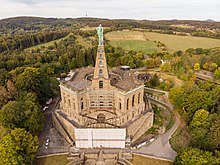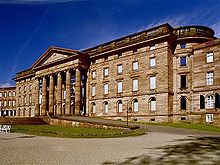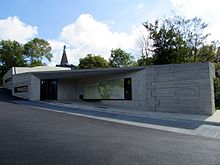Bergpark Wilhelmshöhe
| Bergpark Wilhelmshöhe | |
|---|---|
|
UNESCO world heritage |
|

|
|
| Bergpark with Wilhelmshöhe Castle View of Hercules |
|
| National territory: |
|
| Type: | Culture |
| Criteria : | (iii) (iv) |
| Reference No .: | 1413 |
| UNESCO region : | Europe and North America |
| History of enrollment | |
| Enrollment: | 2013 (session 37) |
The Bergpark Wilhelmshöhe in the north Hessian city of Kassel is the largest mountain park in Europe and a landscape park of world renown with an area of 2.4 square kilometers . On June 23, 2013 it was recognized as a UNESCO World Heritage Site, and it is listed by the German National Tourist Board among the top 100 tourist attractions in Germany.
The park is particularly known for the water features in it , the Hercules with the statue of the same name, Wilhelmshöhe Castle and the artificial ruins of Löwenburg .
overview
The Bergpark Wilhelmshöhe is located in the Bad Wilhelmshöhe district of Kassel . The landgraves and electors of Hessen-Kassel had the park laid out in 1696. It was expanded over the next 150 years.
The mountain park is unique in the history of European garden art : Italian gardens of the baroque were also on hillsides, in terraces created, but never included such a large area, and French baroque park extended only in the plane. Today's park shape, especially in the lower area, is not a baroque garden, but follows the ideas of the English landscape garden .
The mountain park is particularly known for the water features that pour in the park from Hercules over the cascades to the east and Wilhelmshöhe Castle, and for the lavishly designed garden art. The palace park is a reflection of European art and cultural history through several epochs. Georg Dehio , Nestor of the Modern Monument Preservation, says about the park: "... perhaps the most grandiose that the Baroque dared to combine architecture and landscape anywhere."
The state of Hesse presented in January 2012 at the World Heritage Center of UNESCO the request, the mountain park in the list of UNESCO World Heritage take. On June 23, 2013, the application was granted at the 37th session of the UNESCO World Heritage Committee in Phnom Penh. The facility is Germany's 38th World Heritage Site. The park has been part of the European Garden Heritage Network since 2009 . The park has been looked after by the Hessen Kassel Museum Landscape (mhk) since 2006 .
Geographical location
The Bergpark Wilhelmshöhe extends in the area of the westernmost Kassel district, Bad Wilhelmshöhe , and up into the Hohen Habichtswald . It is 2.4 km² in size, which corresponds to the area of around 350 football fields. Some of the sizes are up to 3.0 km². The Karlsberg ( 526.2 m above sea level ) with the Hercules at 515 m belongs to the Habichtswald . The park is bounded to the east by the western edge of the built-up area of Kassel, where Wilhelmshöhe Castle is located at a height of around 282 m . The mountain park is one of the easternmost parts of the Habichtswald nature park .
History and construction phases
In the 17th century there was a wooded slope of the Habichtswald at the site of today's Bergpark, more than five kilometers to the west - and thus far outside - of the former Kassel city limits. The Weissenstein Monastery of the Augustinian Canons was founded from Mainz in 1143 on the site of the current Wilhelmshöhe Palace . It existed as a women's monastery from 1193 and was dissolved after the Reformation in Hesse (around 1517/1518). Landgrave Philip I used the remaining buildings as a hunting seat. From 1606 to 1610, Landgrave Moritz von Hessen-Kassel built a hunting lodge there, which continued to bear the name Weißenstein .
start of building
The Bergpark was created in Baroque form from 1696 under Landgrave Karl , when construction work on Little Hercules (also known as the Alter Winterkasten ) began. Its place of construction, where some remains of walls and foundations still exist, was the Hüttenberg ( 555 m ). However, it was decided to abandon this mountain, which is located about 400 meters south-southeast of today's Hercules , as the focal point of the park and thus as a building site, so that the work was stopped.
In 1696, Landgrave Karl hired the French inventor Denis Papin , who designed a steam pump to operate a water fountain and, along with Thomas Savery, was one of the first inventors of a steam engine - although the pump never worked properly. Karl was not prepared to continue to finance the development, and an attempt to work with Gottfried Wilhelm Leibniz , who was also working on the Herrenhausen Gardens in Hanover for this purpose , failed due to Leibniz's lack of interest.
The park was developed according to current ideas until well into the 19th century. Two construction phases that characterize the park today were particularly important:
The baroque Karlsberg from 1700
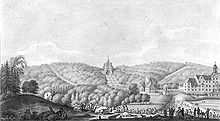
In 1701, the construction of the giant castle, an octagon , and the cascade in front of it began. Landgrave Karl and his Italian architect Giovanni Francesco Guerniero created a water axis based on the feudal taste of the Baroque; on June 3, 1714, the first Sunday of the month, the Kassel water games were presented to the public for the first time. The Hercules statue on the roof pyramid was not erected until 1717. The total length of the system from the water conundrum below the octagon to the Neptune basin, which is located at the end of the 250 meter long cascade, is approximately 320 meters. Original plans to continue this structure down to the castle were not implemented, and the lower area, i.e. three quarters of the slope of the Karlsberg, was initially only slightly redesigned by the end of the 18th century.
The mature landscape park from 1785

Under Landgrave Wilhelm IX. (later Elector Wilhelm I of Hessen-Kassel) began a major renovation and expansion phase in the area between the cascades and the palace after he took office in 1785. At the same time, Weißenstein Castle was demolished from 1786 and rebuilt as Wilhelmshöhe Castle according to the classicist designs by Simon Louis du Ry . In the garden design the ideals had meanwhile shifted from “French rigor” to “English naturalness”: instead of straight baroque axes, surprising paths and viewpoints played the new main role. As part of the redesign and expansion measures from 1785, the buildings by Heinrich Christoph Jussow were built , which still characterize the site today. Jussow, the Landgrave's garden architect, designed the Löwenburg (1793–1800) as an artificial ruin, one of the most important buildings in the mountain park. He developed the castle pond (1785–1791), also called Lac , and expanded the water features with structures such as the fountain pond ( 1789/1790) and the devil's bridge with the hell pond (1792/1793). Jussow also designed the fascinating aqueduct (1788–1792), the architectural reference to a ruined Roman aqueduct, from the height of which the water plunges into a valley 34 meters below. The “fountain inspector” Karl Steinhöfer (1747–1829) also played an important role as the designer of the park and water features ; today's Steinhöfer waterfall (formerly Waldwasserfall , 1793) and the New Waterfall go back to him. Court gardener in those years was Daniel August Schwarzkopf , he expressed the goals of the park redesign as follows:
“Almost the vast majority of walks have their intention and lead to a certain object, which always reward the effort of the walk. A connoisseur and friend of nature will find places in the complex that have their special charm and beauty at any time of the day. One finds pleasant places before the morning and before the hot midday, those before the evening are almost the worst, because the effect of the setting sun cannot really be felt because of the high mountains to the west. All walks are made well and firm, covered with sand and sand, are well maintained and the cleanliness is observed very strictly, even the streets are maintained like "garden paths". "
1806-1866
In 1806 the European upheavals reached the Bergpark Wilhelmshöhe: Napoleon's troops stood in front of Kassel and expelled Elector Wilhelm I. Napoleon's youngest brother, Jérôme Bonaparte , ruled the newly created Kingdom of Westphalia from the castle and Bergpark . The chroniclers of Wilhelmshöhe - now renamed Napoleonshöhe - describe this episode as a time of numerous public festivities and Jérôme gives it the nickname King Lustik . Construction measures in these years included the expansion of the palace - the previous three individual wings were connected by intermediate buildings - and the new construction of a court theater, later the ballroom , right next to the palace.
In 1813, after Napoleon's defeat, the escaped Elector Wilhelm I returned to Kassel and to the Bergpark. His successor, Wilhelm II , had the new waterfall, the last major structure of the water features, built in 1826 . The following Friedrich Wilhelm I sympathized with Austria in the Austro -Prussian War of 1866. The family ties to the Prussian court were no longer of any use: After Prussia's military victory , he was imprisoned and the centuries-long history of the ruling house of Hessen-Kassel, the builders of the mountain park, was over.
1866-1918
Kassel became the Prussian provincial capital and the expansion of the Wilhelmshöhe mountain park was thus finally ended. The Wilhelmshöhe Castle was briefly in 1870 for state prison of the new German Reich: The in French German War defeated Emperor Napoleon III. was a prisoner in Wilhelmshöhe Castle.
From 1899 the German Emperor Wilhelm II used Wilhelmshöhe Palace as an annual summer residence. In the following years, the palace and park were once again a place of action in European politics. After the armistice of Compiègne in November 1918, the castle was the seat of the Great Headquarters until February 1919. Paul von Hindenburg organized and directed the retreat and demobilization of the German army from an outbuilding of the castle after the end of the First World War .
20th century
In the 20th century, there were no contemporary extensions or extensions to the actual park. Only conservation measures were taken, which were intended to preserve the existing substance of the 18th and 19th centuries. In addition, there were infrastructure constructions in the form of roads and parking lots that pose a problematic impairment of the mountain park. Today, paved side streets, some more than six meters wide, lead through the core areas of the park, which can hardly be reconciled with Schwarzkopf's “Garden Paths” (see above).
From 1923 to 1927, well-known racing drivers such as Caracciola , Jörns , Kappler and Rosenberger competed in the Bergpark for the Kassel Mountain Prize . 1951 to 1954 motorcycle races briefly revived this tradition.
today
In the early 2000s, the state government of Hesse pushed ahead with plans to restructure the museums in Kassel in order to make them more attractive to visitors. From this restructuring, the Museum Landscape Hessen Kassel (mhk) emerged in 2006, which also took over the Kassel properties of the administration of the State Palaces and Gardens of Hesse . The mountain park was also affected by this, whereby the application for a World Heritage Site , which had been planned since 1986 , was funded. However, the application had to be suspended for a long time for political reasons, since after 1990 the Federal Republic initially proposed more natural and cultural monuments from the new federal states for inclusion. On June 23, 2013, the mountain park was named a Unesco World Heritage Site.
The park
Landscape image
The size of the mountain park, the complex topography , the extensive network of paths and the influence of weather and seasons mean that even long-term park visitors can offer themselves new impressions and views with every stay. The elaborately designed landscape of the park consists of many loosened green areas and forest sections, which flow into the trees of the surrounding Habichtswald. The park is not clearly delimited, especially in the upper, western area.
Infrastructure
The park's infrastructure mainly includes walking and hiking trails . In addition to the already mentioned side streets that lead through the Bergpark, Wilhelmshöher Allee can also be viewed as part of the overall Baroque concept of Bergpark-Wilhelmshöhe . It was laid out as an approximately 4.5 kilometer long, completely straight east-west axis from the outskirts of Kassel to Wilhelmshöhe Castle and thus also in alignment with the Bergpark and Hercules. Another part of this concept is the lawn avenue , which leads directly from the park north to Wilhelmsthal Castle in the municipality of Calden .
topography
Between the Hercules ( 515 m ; on the slightly higher plateau of the Karlsberg at 526.2 m ), which was built at the highest point of the line of sight Schloss Wilhelmshöhe - Herkules , and the Schloss Wilhelmshöhe (approx. 282 m ), which is in the lower There is a height difference of 238 meters. Down to the western end of Wilhelmshöher Allee at the corner of Mulangstrasse ( 231 m ), where the Bergpark begins, there is an altitude difference of 292 meters.
The Hüttenberg ( 555 m ), on which the remains of the walls and foundations of the Little Hercules (also known as the Old Winter Box) are, represents the highest point on the ridge; its second highest point is the Elfbuchen mountain (551.30 m), which is also located within the Habichtswald but probably just outside the mountain park directly on the wooded border with the Harleshausen district.
The above-mentioned difference in height can be directly experienced by the park visitor: At Herkules it is usually a little cooler and often also windier than at the lower and more protected castle. The topography is also reflected in the vegetation: Above, on the Karlsberg, the planting looks sparse, almost monotonous, conifers predominate. The number of tree species increases towards the bottom until the vegetation at the castle pond (Lac) , which is a little deeper than the castle, appears diverse and almost tropical.
flora
The focus of the planting in Bergpark Wilhelmshöhe is not so much flowers but rather woody plants , i.e. bushes and especially trees . Almost one exception is the collection of roses on the Lac nearby Rose Island . The island was completed in 1795 and the pearl from Weissenstein cultivated there from 1795 is considered to be the first rose cultivation in Germany.
The dominant role of trees and shrubs goes back to the late 18th century when the park was redesigned based on the English landscape park. Planting and thus collecting many different tree species from different countries of origin was a phenomenon of the times that arose from the emerging interest in natural history. In 1777 329 species were counted, 128 of them from North America. A list from 1785 lists 431 species. The first woody plants from foreign continents came mainly from the North American Atlantic coast, at the beginning of the 19th century also increasingly from the American Pacific coast and from the middle of the 19th century from Asia.
The park is still characterized by the diverse tree and shrub population from all over Europe, North America and Asia. The tradition of publishing printed brochures, which dates back to 1955, was continued in 2019 with World Heritage Bergpark Wilhelmshöhe - Trees and Shrubs . Around 700 trees in the mountain park are numbered and recorded in this revised dendrological guide, with several species occurring more than once. As part of this revision, around 50 trees were replanted.
Horticultural management
Over the centuries, changes in the park have also been linked to the person of the horticultural manager, originally the court gardener . So with Daniel August Schwarzkopf the change to the English landscape park at the end of the 18th century. Later leaders were:
| from | to | title | Surname |
|---|---|---|---|
| 1822 | 1864 | Court garden director | Wilhelm Hentze |
| 1864 | 1891 | Court gardener | Franz Vetter |
| 1891 | 1898 | Court gardener | Gustav Adolf Fintelmann |
| 1898 | 1918 | Court gardener | Ernst Virchow |
| 1918 | 1938 | Gardening director | Rudolf Hörold |
| 1945 | 1959 | Horticultural inspector | Helmuth Junggebauer |
| 1959 | 1970 | Horticultural inspector | Alexander Bothmann |
| 1970 | 2003 | Horticultural Council | Hermann Mielke |
Water features
An important element in Bergpark Wilhelmshöhe is water. One encounters it in the form of enclosed pools or seemingly natural ponds and lakes, as a stream and as a cascade . Especially in the main axis of the park (Hercules Castle), water is always present, visible and often audible, bubbling and gurgling. A small amount of water constantly flows down the mountainside, past the castle, towards the castle pond, the Lac .
The landgraves and their architects had water structures built, with which large quantities can be used for the water features (historically also known as " water arts "). For this purpose, rain and surface water is collected in storage basins on the heights of the Habichtswald via a system of ditches. One of them is the Sichelbach basin , which is 6300 square meters in area, seven meters deep and 40,000 cubic meters in volume at the Vorwerk Sichelbach approx. 1 km west of the Hercules.
The water features are still based on centuries-old technology, only work with the existing gradient and therefore do not require pumps. All slides must be opened and closed by hand. The water needs about ten minutes to completely pass through the individual locations. Today, the process is designed in such a way that visitors can follow the water from top to bottom and can view all the stations and water images in the course of 1 hour and 15 minutes.
In a complex choreography, the water passes through a series of buildings erected solely for this purpose. The total amount of water that can be used for the staging is 2100 m³. All this water first flows into the Schlossteich, the Lac , via its outlet into the Drusel , and from there to the Karlsaue into the Fulda.
procedure
The starting point for the fountains in the park is, then as now, the Hercules structure, more precisely the grottoes, cascades and pools in front of the octagon to the east and down the slope. From top to bottom:
- Vexierwassergrotte (with a hydraulically operated roller organ , the so-called water organ ) and artichoke basin , framed by the curved cascades on both sides .
- Giant head plateau , framed by the semicircular cascades on both sides .
- The central large cascades with the upstream Neptune basin and the Neptune grotto .
This oldest, baroque part of the water features, created under Landgrave Karl , is followed downhill by the stations of the later, romantic area, created under Landgrave Wilhelm IX :
| Steinhöfer waterfall | 15:05 |
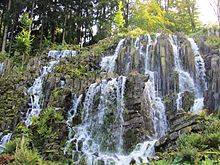
|
The structure, originally called the forest waterfall because of its location, was built between 1792 and 1793 according to plans by Carl Steinhofer.
During the water games, 430 m³ of water, 50 m wide, can fall 20 m deep. Outside of the water features, the building can be read as an abandoned quarry from the 18th century, which nature is recapturing and which is overgrown. In the middle there are basalt steles that are being dismantled, as well as inferior stones that have been left standing. There are dismantled steles that should be removed and scree slopes from overburden. |
OSM link to the map display: Steinhöfer waterfall | |
| Waterfall at the Devil's Bridge | 15:20 |
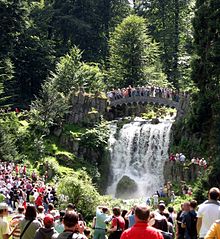
|
Built 1791 - 1793 according to plans by Heinrich Christoph Jussow , today's Iron Devil's Bridge , designed by Johann Conrad Bromeis , replaced a previous wooden building in 1826.
During the water games, 400 m³ of water fall 10 m deep in 10 minutes. The waterfall and the bridge are a reference to the historic Devil's Bridge in the Swiss Alps , over the Reuss . The scenery during the water games reflects the alpine snowmelt with its drama. |
OSM link to the map display: Devil's Bridge | |
| aqueduct | 3:30 p.m. |
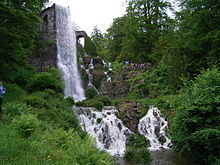
|
Built 1788 - 1792 according to plans by Heinrich Christoph Jussow .
During the fountains, 400 m³ of water fall about 30 m in 10 minutes. As a replica of a historical aqueduct , the building refers to antiquity and its technical achievements. in its destruction it can - like the Steinhöfer waterfall - be seen as a symbolization of a conflict between nature and technology. |
OSM -Link to the map display: Aqueduct | |
| Big fountain | 15:45 |
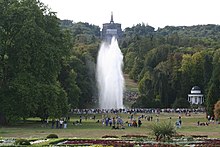
|
The large fountain in the fountain pond is fed via an underground pipe from the fountain reservoir above .
During the water games, 200 m³ of water are thrown about 50 m high in 10 minutes. The great fountain is considered the highlight of the water features. A fountain that existed at the beginning of the 18th century was rebuilt and relocated decades later and only reached today's geyser-like shape and height in the second half of the 18th century . |
OSM link to the map display: Large fountain in the fountain pond |
The New Waterfall was not included in the process again after being damaged in World War II.
Event dates
From May 1 to October 3, the Kassel water games take place every Wednesday, Sunday and on Hessian public holidays (originally and sometimes also today referred to as water arts ). It starts at 2:30 p.m. at the foot of Hercules. Every first Saturday of the month (June to September) there are illuminated water features in the evening (June / July at 9.45 p.m., August at 9.15 p.m., September at 8.45 p.m.), in which the individual locations are illuminated in color . Admission is free, but accessibility is rather limited. The event sometimes attracts up to several thousand visitors - especially when the weather is good in midsummer and on Sundays.
Buildings in the mountain park
Wilhelmshöhe Castle
The nucleus of the entire mountain park is Wilhelmshöhe Castle (approx. 282 m ), which is located on the easternmost and lowest point of the Wilhelmshöhe - Herkules sightline. Landgrave Moritz von Hessen-Kassel had a hunting lodge built on the site of the Augustinian monks' former Weißenstein monastery from 1606 to 1610, from which Wilhelmshöhe Palace developed from 1786 and 1798. Nowadays it contains, among other things, the Old Masters Picture Gallery and the Antique Collection.
Hercules
On the westernmost and highest point of the line of sight Schloss Wilhelmshöhe - Herkules stands the Herkules ( 515 m ) , which was built between 1701 and 1717 . The building (71 meters high) is considered the landmark of Kassel and stands - visible from afar - on the easternmost mountain ridge of the Habichtswald. The cascades in front of the Hercules are the starting point for the numerous Kassel water games.
Löwenburg
In the southern part of the mountain park and thus south of the line of sight Schloss Wilhelmshöhe - Herkules is the Löwenburg at about 350 m height. It was designed by Heinrich Christoph Jussow between 1793 and 1800. The Löwenburg is an imitation of a medieval English knight's castle and, in a romantic historicizing way, was deliberately built as a decaying partial ruin. Bombs destroyed one of the towers during World War II. This is to be restored or rebuilt over the next few years. Another tower has already been designed and built as a decaying ruin.
Greenhouses
There are several greenhouses in Bergpark Wilhelmshöhe:
- The large greenhouse is a little west-northwest of the ball house . It is one of the very first steel and glass constructions and was built in 1822 according to plans by J. C. Bromeis. The builder was Elector Wilhelm II. In 1887 the originally round central building was replaced by a cubic palm house. Today it can be visited from October to May.
- Several other simple preserved greenhouses are to the west of the former stables. Most of them date from the 20th century and are now used by the Wilhelmshöhe nursery.
More buildings
- The ballroom is located directly north of Wilhelmshöhe Castle . King Jérôme von Westphalen, Napoleon's youngest brother, had it built as a court theater by Leo von Klenze from 1809 to 1810 . The free-standing, classical building was placed next to the north wing of the palace and is an early work by the later famous architect. Between 1828 and 1830 it was converted into a ballroom by Johann Conrad Bromeis under Elector Wilhelm II of Hessen-Kassel . It was used less by the farm itself than by the hotel opposite. Today it is used by the Hessen-Kassel museums as an exhibition and event building.
- The cascade overseer's house is located directly below the Hercules, at the Neptune Basin. It was built between 1803 and 1809 according to plans by Heinrich Christoph Jussow as a single-storey, stone-faced solid building with moderate echoes of revolutionary architecture . In the early years it was the home of the park rangers, after which it has been used as an inn for park visitors to this day.
- The Schlosshotel Wilhelmshöhe is located directly adjacent to the mountain park . In 1827 the first hotel was built here under Elector Wilhelm II as the client. In the Second World War, however, this was destroyed, so that in 1955 a new hotel was opened according to plans by Paul Bode . The hotel achieved outstanding importance in German history, as it was from here that Paul von Hindenburg organized the retreat and disbandment of the troops after the First World War, and it was here that discussions between Willy Brandt and Willi Stoph took place within Germany.
- The old station building at the terminus of the current tram line 1 was built in 1898. It currently houses one of two visitor centers in the Wilhelmshöhe mountain park .
Economic area
In the economic area north of Wilhelmshöhe Castle, on the other side of Tulpenallee / Wilhelmshöher Allee, there were areas and buildings for supplying the farm as well as the gardening area. Today, this area is largely characterized by paved roads and parking lots.
| Stables |

|
Built in 1791 according to plans by Heinrich Christoph Jussow , rebuilt and expanded in 1822 by Johann Conrad Bromeis , a three-winged horse stable with chambers on the upper floor, which is grouped around an inner courtyard.
Today the depot of the Bergpark Wilhelmshöhe is located in the Marstall building. The so-called gardener's house forms the northern end of the western stables wing . Today it houses the garden administration. |
OSM link to map display: Marstall | |
| Cavalier House |
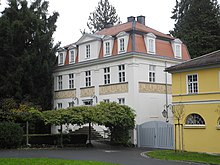
|
The building, which was initially built under Landgrave Friedrich II as a court gardener's apartment and converted around 1780 by Simon Louis du Ry as a home for the mounted bodyguard, was moved and rebuilt in 1825 according to plans by Johann Conrad Bromeis .
Today the house is one of the administration buildings of the Hessen Kassel Museum Landscape. |
OSM link to the map display: Kavalierhaus | |
| Riding arena |

|
The riding hall from 1797 forms the northern end of the Marstallhof. The half-timbered building is used for concerts and readings in the summer months. | OSM -Link to the map display: Reithalle | |
| Guard house |
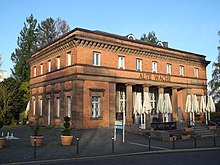
|
The former guard house, also known as the Alte Wache , was built between 1824 and 1826 according to plans by Johann Conrad Bromeis .
There has been a café in the classicist building for a long time (formerly the Schlosscafé , now the Alte Wache ). |
OSM link to map display: Guard house | |
| Old post |

|
In the former post office, which was built in 1897 for Kaiser Wilhelm II, who regularly spent the summers in the neighboring Wilhelmshöhe Palace, is now the museum education department of the Hessen Kassel Museum Landscape. | OSM link to the map display: Alte Post | |
| Remise |

|
The former coach house is no longer in its original condition; it has been used as a conference venue by the castle hotel since 1990. | OSM link to map display: Remise | |
| Ice cellar |
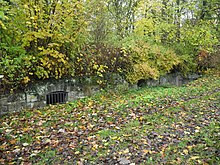
|
The vaulted cellar was built around 1768. | OSM link to the map display: ice cellar |
Staffage buildings
The architectural element of the staffage has a long tradition in garden architecture. But especially in Baroque garden art, it has a central function and takes on a mediating position between architecture and nature.
In the Bergpark Wilhelmshöhe there are numerous small staffages that cannot be assigned any direct function. They are often a bit off the line of sight Schloss Wilhelmshöhe - Herkules , the main park axis , on the border to the undeveloped forest. Each staffage is unique, quotes art and cultural history and marks a special vantage point in the park landscape. Some of the staffages preserved in the park today come from the reign of Landgrave Friedrich II , so they were erected between 1760 and 1785 and integrated into the extensive "English" redesign in the years from 1785 onwards.
| Cestius pyramid |

|
Built around 1775 according to plans by Simon Louis du Ry . The pyramid was built south of the main axis of the park and a little above the fountain pond. The tufa building has a square footprint with a side length of about six meters. It is modeled on the ancient Cestius pyramid , the tomb of Gaius Cestius Epulo , in Rome. | OSM link to map display: pyramid | |
| Virgil's tomb |

|
Built around 1775 according to plans by Simon Louis du Ry . The stone structure stands a little north of the main axis of the park. The building on a square floor plan with a side length of approx. Five meters and an attached column stump is named after the Roman poet Publius Vergilius Maro and is based on his tomb near Naples. | OSM link to map display: Tomb of Virgil | |
| Hermitage of Socrates |

|
Built in wood in 1775 according to plans by Simon Louis du Ry , a stone and half-timbered replica took place at the beginning of the 19th century. The hut, similar to a hermitage, is clad with tree bark on the front. The building is located on the edge of the forest to the southeast of the Teufelsbrücke , the view aisle at its feet allows a wide view. In this building, dedicated to the Greek philosopher Socrates , there were also pavilions until the end of the 18th century, which were reminiscent of Heraclitus , Archimedes and Democritus , for example . Originally the buildings were accessible and inside there were wax or plaster figures of the ancient scholars. | OSM -Link to the map display: Hermitage of Socrates | |
| Mercury temple |

|
Built in wood from 1782 - 1783 according to plans by Simon Louis du Ry , rebuilt in stone in 1823 by Johann Conrad Bromeis . The open, round domed building with a diameter of six meters has eight columns and refers to the god Mercurius . Its model was the Temple of Venus in the English landscape garden of Stowe . During the Second World War, the temple lost its dome and the statue of Mercury. Both were restored in 2013/2014. | OSM link for map display: Temple of Merkur | |
| Pluto grotto |

|
Built 1766 - 1768, renovated in 1820 according to plans by Simon Louis du Ry and Johann Conrad Bromeis . The name of the building, directly in the main axis of the park, is the Roman god Pluto . Originally, the windows and doors were colorfully glazed, and the plaster inside depicted mythological scenes of horror and the underworld. The building is no longer in its original state, windows and doors as well as the interior figures are missing. For a few years now, two stone sea monsters by Johann August Nahl the Elder have been standing in the outer wall niches . The sculptures originally came from Wilhelmsthal Castle and were on the facade of the Pluto grotto from 1798 until the end of the 19th century. |
OSM link to the map display: Pluto Grotto |
The “Chinese village” Mou-lang , the remains of which stand on the south-eastern edge of the mountain park on the slope above the Lac , plays a special role. The ensemble was built from 1781 under Landgrave Friedrich II, renewed and further developed by Landgrave Wilhelm IX. (Elector Wilhelm I). On the one hand, Mou-lang was a contemporary chinoiserie , but the "village" and its "inhabitants" also served agricultural purposes.
There were also numerous sculptures placed in the park, for example from Greek mythology , which are no longer preserved today. The colorful mix of different architectural styles and epochs does not seem strange to today's observer, it was different for contemporaries at the time, the landgrave's hodgepodge could well be considered "avant-garde". The irritation is still present over a hundred years later, when Paul Heidelbach wrote in his standard work The History of Wilhelmshöhe in 1909 :
- “... The contrary to style of such an anachronism was all the more imposed as the individual monuments belonging to their style according to different epochs and peoples often caught the eye at the same time. For those who like to walk, who are free of stylistic concerns, these varied presentations may be a delightful feast for the eyes, and, as contemporaries used to say, “put him in a touching astonishment”; the aesthetician felt even then that this aroused a mixture of ideas in the viewer that distracted the eye and could not be connected with one another at all. Today, when some of these creations have long since disappeared, the other is covered by dense bushes, forming a world of its own, as it were, the fantastic, playful character of these new Friederician installations is less unpleasant ... " ( Lit .: Heidelbach, 1909)
As part of the redesign under his successor Landgrave Wilhelm IX, the later Elector Wilhelm I in the years from 1785 onwards, numerous staffages disappeared, but new ones were also added:
| Felseneck |

|
Built in 1794 according to plans by Heinrich Christoph Jussow . The octagonal stone building stands on the edge of the forest to the north below the cascades. Divided into a vestibule, cloakroom and cabinet, it served as a rest and refreshment room. | OSM link to map display: Felseneck | |
| Hall of Socrates |

|
Built 1813–1816 according to plans by Heinrich Christoph Jussow . The semicircular columned hall, also known as the half-round temple , stands on the bowling green west of Wilhelmshöhe Palace. | OSM link to the map display: Hall of Socrates | |
| Jussow Temple |

|
Built 1817 - 1818 according to plans by Heinrich Christoph Jussow . The temple with its open colonnade and closed interior stands at the fountain pond at the end of the Peneus cascades . He finds his role model in Stowe, England. The temple of Jussow is still often referred to as the temple of Apollo. The confusion is due to the fact that the Jussow Temple was built up the slope shortly after a temple was demolished. This small wooden structure, called the Temple of Apollo, dates from the time of Frederick II. | OSM -Link to the map display: Jussow-Tempel |
The overseer's house on the cascades , which was built in 1810 on the Neptune basin below the cascades, plays a special role. It was created under the reign of King Jérômes. Jussow was clearly inspired by French revolutionary architecture. The building is now used as an excursion restaurant.
Bergpark, city and citizens
The feudal landgrave park is now owned by the State of Hesse and freely accessible to everyone at any time. The location of Bergpark Wilhelmshöhe - in the past far ahead, today on the outskirts of the city - means that the site is still not an urban “citizens' park”: visitors to the park consciously stay there, have traveled specially and not only cross it random. After dark, the unlit park in the core areas (only the castle and Hercules are illuminated) is usually deserted.
The mountain park now forms the backdrop for a wide variety of events and activities: the Bundeswehr has already used the park for public vows of recruits, artists for exhibitions, such as the nocturnal light (e) paths between 2002 and 2005. However, individual citizens are also suitable - often unofficially - on: While some use the park for medieval role-playing games, others drum regularly on the summer full moon nights. The caves in the mountain park have also been used for music and sound recordings. A traditional winter institution is ice skating on the frozen lake and tobogganing on the castle slope. Every two years the mountain park is the backdrop for the Hercules Mountain Prize and further annually for the traditional Hercules mountain run from the reform school up to the Hercules .
Literary mentions
The writer Christine Brückner , who lives in Kassel, wrote about Bergpark Wilhelmshöhe:
"The Wilhelmshöhe Nature Park is a total work of art made up of architecture, sculpture, water art and landscape."
Jamal Tuschick mentions the Bergpark Wilhelmshöhe in his novel Kattenbeat :
"She insisted on remembering how we met in Park Wilhelmshöhe ... you were just making a run to storm the cascades."
Visitor centers
Visitors to Bergpark Wilhelmshöhe can find out more in two visitor centers: in 2008 the Wilhelmshöhe visitor center was opened in the old station building at the terminus of tram line 1 at the east foot of the Bergpark and in 2011 the 550 m² Herkules visitor center west of the park near the Oktogon. In their shops, tickets, books and other products related to the museum landscape Hessen Kassel and refreshments can be purchased. Diagrams with texts give information about the park. Employees of the Hessen-Kassel Museum Landscape are available to answer questions. In the visitor center Herkules film presentations are often shown.
traffic
Transport links and hiking
The park can be visited with the buses and trams of the Kasseler Verkehrs-Gesellschaft (KVG): trams of line 1 coming from the city center go via Wilhelmshöher Allee and through the stop at Kassel-Wilhelmshöhe train station ( ICE connection) to the lower edge of the park Wilhelmshöhe (park) is the final stop below Wilhelmshöhe Castle . Buses on line 23 (Bergparkbus) and those on the same line also go there from Wilhelmshöher Bahnhof through the Drusel valley in the Habichtswald south past the park up to the Hercules; Trams of the KVG line 4, which also comes from the city center, also run to the Druseltal stop . On days with water features, a shuttle bus from the Hesse Museum Landscape Kassel (mhk) connects the castle, aqueduct, and Plutogrotte from the Wilhelmshöhe (Park) stop across the lower and middle parts of the park , Cascade economy and Löwenburg together.
The large parking spaces at the two visitor centers have been expanded in recent years.
The hiking trails Habichtswaldsteig , Herkulesweg , Kassel-Steig , Märchenlandweg and Studentenpfad lead past the Herkules ; Herkulesweg and student path run through the park, the Kassel-Steig through the upper parts of the park. Due to the large difference in height in the park, the water features are sensible to hike downhill parallel to the path of the water from the Hercules.
Avenue of tulips
The historic Tulpenallee is the extension of Wilhelmshöher Allee and is now part of Landesstraße 3217. Due to the traffic policy of the last decades, the Parkweg has become a car entry and exit route in Kassel. Motor vehicle traffic causes noise emissions in the park that are no less than on the inner-city part of Wilhelmshöher Allee or, for example, Kölnische Strasse. This means a reduced quality of stay in large parts of the northern park area. The part of the park east of the avenue of tulips, at the forest school, appears separated and crossing the avenue can be considered risky at some times of the day.
In 2015, an average daily traffic volume of 5207 vehicles, 38 of them heavy traffic, was recorded on the lawn avenue, the extension of the tulip avenue north of the mountain park. This is significantly more than, for example, on the L3298, the Druseltalstraße or Ehlener Straße from Kassel through the Habichtswald to the west. In 2015, only 3,628 vehicles were counted there in 24 hours.
The Tulpenallee itself, which begins at Wilhelmshöhe Castle, is passed by around 6000 vehicles on a normal working day.
Mulang Street
Mulangstraße branches off to the southwest from Wilhelmshöher Allee and crosses the historic village of Mulang . Today, the historic Parkweg is an asphalt road and another approach for the urban residential areas south of the mountain park, which are already accessible from the south. It separates the historic village. Only a few park visitors should be aware that there is a park on both sides of Mulangstrasse.
“Mulangstrasse, which runs along the eastern edge, is also heavily frequented and regularly parked.” Wrote the authors of the Parkpflegewerk zum Bergpark in 2007 . Nothing has fundamentally changed in this respect, around 2000 vehicles pass the road on a normal working day.
Core zone
There are parking spaces at the Löwenburg and at the Kaskadenwirtschaft restaurant ; Since 2008, however, direct access has usually been restricted and only possible via an intercom. The lease agreement with the Kasakdenwirtschaft in the former supervisor's house allows car traffic on the municipal road in the core area of the park.
References and comments
- ↑ UN cultural organization: Unesco names Kassel Hercules World Heritage , Spiegel Online , June 23, 2013
- ↑ The TOP 100 sights in Germany , German National Tourist Board, accessed on June 4, 2015, on germany.travel
- ↑ World Heritage application “Water arts and Hercules in Bergpark Wilhelmshöhe” in Paris handed over to UNESCO ( memento from June 23, 2015 in the web archive archive.today ), Hessian Ministry of Science and Art , January 18, 2012, accessed on June 23 2013, from verwaltung1.hessen.de
- ↑ Kassel Bergpark Wilhelmshöhe is a UNESCO World Heritage Site. Press release. German UNESCO Commission eV , June 23, 2013, accessed on June 23, 2013 .
- ↑ Marcel Hänggi: Stories of Progress. For a good use of technology , Frankfurt am Main 2014. pp. 57–58.
- ↑ The thesis contradicts the latest research, both aspects rather complemented each other. For example, clear axes and main lines were connected by surprising routes. Compare e.g. B. in conclusion, Stobbe 2009.
- ↑ Paul Anbich: Journey from Schora to Neunkirchen 1889 , in: Stefan Wolter: Pastor children in the world war. A hospital diary and a field diary by Tutti and Martin Anbich 1914–1918 (series Denk-MAL-Prora , Vol. 6), pp. 357–366. Projekt-Verlag 2014, ISBN 978-3-95486-455-3
- ↑ UNESCO finds Kassel's Bergpark Wilhelmshöhe great , from June 23, 2013, on dw.com ( Deutsche Welle )
- ^ Paragraph after Alfred Hoffmann, Herrmann Mielke: Kassel - Schlosspark Wilhelmshöhe - trees and bushes. ed. vd Administration of the State Palaces and Gardens of Hesse. 3rd revised edition. Bad Homburg 1994, pp. 3-7
- ↑ Figures from Siegfried Hoß and Kirsten Schröder-Spengler: World Heritage Bergpark Wilhelmshöhe - Trees and Shrubs , Park Brochures MHK, Vol. 6, 1st edition, 2019 p. 7
- ↑ Terms of office and title of the table after chapter or chapter headings 1.6 (p. 157) to 1.9.4 (p. 206) in Park Wilhelmshöhe Kassel Parkpflegewerk , 2007
- ↑ Set in a sentence according to Siegfried Hoß: World Heritage Bergparkpark Wilhelmshöhe. The water arts , park brochures MHK Volume 2, 2014, data and facts from the world heritage application , p. 105
- ↑ A replica that is true to the original is to go back into operation in 2021.
- ^ To Park Wilhelmshöhe Kassel Parkpflegewerk , 2007, p. 307
- ↑ Dimensions in paragraph according to Siegfried Hoß: World Heritage Bergparkpark Wilhelmshöhe. The Water Arts, Park Brochures MHK Volume 2, 2014, data and facts from the World Heritage application , pp. 103-104
- ^ Paragraph after Siegfried Hoß: World Heritage Bergparkpark Wilhelmshöhe. The water arts , park brochures MHK Volume 2, 2014, Steinhöfer Wasserfall pp. 60 - 64
- ↑ after Park Wilhelmshöhe Kassel Parkpflegewerk , 2007, p. 308
- ↑ Dimensions in paragraph according to Siegfried Hoß: World Heritage Bergparkpark Wilhelmshöhe. The water arts , park brochures MHK Volume 2, 2014, data and facts from the world heritage application , p. 104
- ^ Paragraph after Siegfried Hoß: World Heritage Bergparkpark Wilhelmshöhe. The water arts , park brochures MHK Volume 2, 2014, Steinhöfer Wasserfall p. 64
- ↑ after Park Wilhelmshöhe Kassel Parkpflegewerk , 2007, p. 309
- ↑ Dimensions in paragraph according to Siegfried Hoß: World Heritage Bergparkpark Wilhelmshöhe. The water arts , park brochures MHK Volume 2, 2014, data and facts from the world heritage application , p. 104
- ^ Paragraph after Siegfried Hoß: World Heritage Bergparkpark Wilhelmshöhe. The water arts , park brochures MHK Volume 2, 2014, Steinhöfer Wasserfall p. 69
- ↑ Dimensions in paragraph according to Siegfried Hoß: World Heritage Bergparkpark Wilhelmshöhe. The water arts , park brochures MHK Volume 2, 2014, data and facts from the world heritage application , p. 104
- ^ Paragraph after Siegfried Hoß: World Heritage Bergparkpark Wilhelmshöhe. The water arts , park brochures MHK Volume 2, 2014, Steinhöfer Wasserfall p. 73 - 80
- ^ City of Kassel: City portal - water arts - water games. Retrieved June 3, 2018 .
- ^ City of Kassel: City portal - illuminated water arts. Retrieved June 3, 2018 .
- ↑ a b c d Water arts and Hercules in the Bergpark Wilhelmshöhe. Nomination for entry in the UNESCO World Heritage List. Nomination dosage. (No longer available online.) Archived from the original ; accessed on August 21, 2017 . , Hessian Ministry for Science and Art (applicant), Dr. Verhoeven, Jennifer (editor) (2011), nominations, Kassel: bird, p. 67 (PDF; 44.6 MB)
- ↑ a b c d after Park Wilhelmshöhe Kassel Parkpflegewerk , 2007, p. 333
- ↑ after Schmuckstück im Bergpark , HNA 2009-12-19, online at https://www.hna.de/kassel/schmuckstueck-bergpark-574427.html accessed 2019-11-18
- ↑ a b c from Park Wilhelmshöhe Kassel Parkpflegewerk , 2007, p. 317
- ↑ after Park Wilhelmshöhe Kassel Parkpflegewerk , 2007, p. 318
- ↑ to Park Wilhelmshöhe Kassel Parkpflegewerk , 2007, p. 315
- ^ After Park Wilhelmshöhe Kassel Parkpflegewerk , 2007, p. 323
- ^ To Park Wilhelmshöhe Kassel Parkpflegewerk , 2007, p. 322
- ^ To Park Wilhelmshöhe Kassel Parkpflegewerk , 2007, p. 321
- ^ The grottoes in the Bergpark Wilhelmshöhe in Kassel. Retrieved July 18, 2020 .
- ↑ Visitor centers: Wilhelmshöhe visitor center and Herkules visitor center , at museum-kassel.de
- ↑ cf. on the sentence: Noise mapping 2017, online in Lärmviewer Hessen at http://laerm.hessen.de/mapapps/resources/apps/laerm/index.html?lang=de accessed 2019-07-22
- ↑ Figures in sales to Hessen Mobil - road and traffic management : traffic volume map Hessen - excerpt from Kassel, 2015 edition
- ↑ a b Figures on the traffic volume according to the traffic volume map of the city of Kassel, status 2010, online at https://www.kassel.de/verkehr-und-mobilitaet/verkehrszaehler/14_10_Verkehrsmodell_Analyse-Nullfall_2010_Kfz__DTVw5_.pdf accessed 2019-11-06
- ↑ Quoting from Horst Becker and Michael Karkosch: Inventory , in Parkpflegewerk , 2007, p. 338. “Also” here refers to the Tulpenallee
literature
- Irmtraud Baier: Unparalleled Italy. Travel to Italy, image of Italy and reception of Italy around 1700 using the example of Landgrave Karl von Hessen-Kassel (= Hessian research on historical regional and folklore , volume 53), Association for Hessian History and Regional Studies Kassel 1834 e. V., Kassel 2010, ISBN 978-3-925333-53-8 (Dissertation University of Marburg 2007, 387 pages, illustrations, cardboard, 23 cm).
- Horst Becker: The total work of art “Wilhelmshöhe” in Kassel . In: Die Gartenkunst 17 (2/2005), pp. 247-310.
- Winfried Bergmeyer: Landgrave Karl von Hessen-Kassel as client. Functions of architecture between vision and reality. Diss. Marburg 1995 (Oktogon. Studies on Architecture and Urban Development, Vol. 17). Munster 1999.
- Marianne Bolbach: History and social significance of the Bergpark Wilhelmshöhe. Kassel 1988.
- Horst Becker and Michael Karkosch: Park Wilhelmshöhe, Parkpflegewerk. Bad Homburg / Regensburg 2007, ISBN 978-3-7954-1901-1
- Peter Gercke: Herakles Farnese in Kassel. In: Art in Hesse and the Middle Rhine. 22, 1982, pp. 29-35.
- Michael Hannwacker: Carlsberg near Kassel. The Weißenstein under Landgrave Karl. Comprehensive University Kassel 1992, DNB 930937198 (Dissertation Comprehensive University Kassel 1992, 5 microfiches 24x).
- Paul Heidelbach : The history of Wilhelmshöhe. Leipzig 1909. (Reprint: edited by Dieter Carl, Vellmar 2005)
- Alfred Hoffmann, Herrmann Mielke: Kassel - Wilhelmshöhe Palace Park - trees and bushes. ed. v. d. Administration of the State Palaces and Gardens of Hesse. 3rd revised edition. Bad Homburg 1994.
- Albrecht Hoffmann , Helmuth Schneider (Ed.): Technology and magic of historical water arts in Kassel. From the Guernieros cascades to the Steinhöfers waterfalls. Kassel 2000.
- Siegfried Hoß: Imperial colors - rekindled! In: Worth seeing. Issue 4, visitor magazine of the administration of the State Palaces and Gardens of Hesse, Bad Homburg 2008, p. 42.
- Cornelia Jöchner: Geometry or Landscape. Dissolution of the baroque garden borders on Karlsberg in Kassel. In: Jörg Jochen Berns, Detlef Ignasiak (ed.): Early modern court culture in Hesse and Thuringia. (Jenaer Studien Vol. 1.) Erlangen / Jena 1993, pp. 142–166.
- Michael Karkosch: Time travel to the turn of the century, Kaiserpark Wilhelmshöhe in Kassel. In: Worth seeing. Booklet 4, visitor magazine of the administration of the State Palaces and Gardens of Hesse, Bad Homburg 2008, p. 28 f.
- Michael Karkosch: Left behind at home, Erdmann - His Majesty's favorite piece. In: Worth seeing. Booklet 4, visitor magazine of the administration of the State Palaces and Gardens of Hesse, Bad Homburg 2008, p. 35.
- Jutta Korsmeier: Water arts in the Wilhelmshöhe Castle Park. ed. vd Administration of the State Palaces and Gardens of Hesse. Bad Homburg / Regensburg 2000, ISBN 3-7954-1287-0 .
- Thomas Ludwig: The Hercules in Kassel. Hercules, octagon and cascades in the Wilhelmshöhe Palace Park. (Edition of the Administration of the State Palaces and Gardens of Hesse, Vol. 22). Regensburg, 1st edition 2004. ISBN 3-7954-1668-X .
- Christiane Lukatis, Hans Ottomeyer (Ed.): Hercules. Hero of virtue and ideal of rulers. The Hercules Monument in Kassel-Wilhelmshöhe. (on the occasion of the exhibition of the same name in Kassel), Eurasburg 1997.
- Bernd Modrow, Claudia Gröschel: Princely pleasure, 400 years of garden culture in Hesse. Schnell und Steiner publishing house, Bad Homburg / Regensburg 2002, ISBN 3-7954-1487-3 .
- Bernd Modrow: The Italian influences on the baroque Karlsberg near Kassel. In: The garden art of the baroque. (Workbooks of the Bavarian State Office for Monument Preservation, Vol. 103). Munich 1999, pp. 58-63.
- Bernd Modrow: The water arts and water facilities in Park Wilhelmshöhe. History of restoration problems, garden monument preservation task . In: Die Gartenkunst 6 (1/1994), pp. 139–152.
- Dunja Richter: The scent of the big wide world, Wilhelminian plant house architecture in Kassel. In: Worth seeing. Issue 4, visitor magazine of the administration of the State Palaces and Gardens of Hesse, Bad Homburg 2008, p. 30.
- Helmut Sander: The Hercules building in Kassel-Wilhelmshöhe. Kassel 1981.
- Dagmar Sommer: Delineatio Montis in Nummis. The commemorative coins on the Kassel mountain park. In: Inken Forman, Michael Karkosch (ed.): Everything seems to be nature, art is so happily hidden. Commemorative publication Bernd Modrow. Munich 2007, pp. 195-204.
- Urte Stobbe: Kassel-Wilhelmshöhe. A noble pleasure garden in the 18th century. (Studies in Art History, Vol. 161). Diss. Göttingen 2008, Berlin / Munich 2009.
- Agnes Tieze : Crowned by Hercules. The ideal brochures Jan and Rymer van Nickelens for Landgrave Karl. (Staatliche Museen Kassel. Monographic Series Vol. 13). Kassel 2004.
- Administration of the State Palaces and Gardens of Hesse, ComputerWorks AG, Michael Karkosch: Kassel-Wilhelmshöhe, garden monument conservation target planning with VectorWorks landscape. Loerrach 2007.
Web links
- Literature about Bergpark Wilhelmshöhe in the Hessian Bibliography
- Opening times, special events, brief description of the Bergpark and the Bergpark app , in: UNESCO World Heritage Bergpark Wilhelmshöhe , management of the park by the Hessen Kassel Museum Landscape, at museum-kassel.de
- The Bergpark Wilhelmshöhe: Kassel's World Heritage Site , presentation of the HNA , on storify.com
- Friedrich Forssman: Kassel-Wilhelmshöhe "Chinese village" and Mulang villa colony in: Description of the facility and especially the surrounding area with many historical photographs , on kassel-wilhelmshoehe.de
- Bergpark Wilhelmshöhe - World Heritage Site , with descriptions of the sights, on kassel.de
- Wilhelmshöhe Kassel - information system about the largest mountain park in Europe , on, wilhelmshoehe.de
- Water arts and Hercules in the Bergpark Wilhelmshöhe. Nomination for entry in the UNESCO World Heritage List. Nomination dosage. Retrieved November 30, 2019. , Hessian Ministry for Science and Art (applicant), Dr. Verhoeven, Jennifer (editor) (2011), nominations, Kassel: bird, 295 p. (PDF; 44.6 MB)
Coordinates: 51 ° 19 ′ 0 ″ N , 9 ° 24 ′ 0 ″ E

